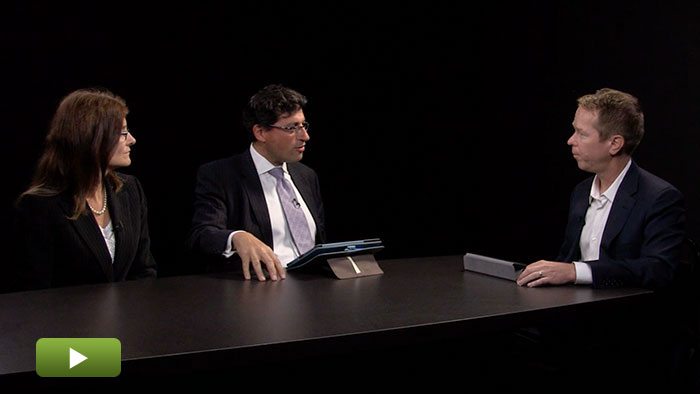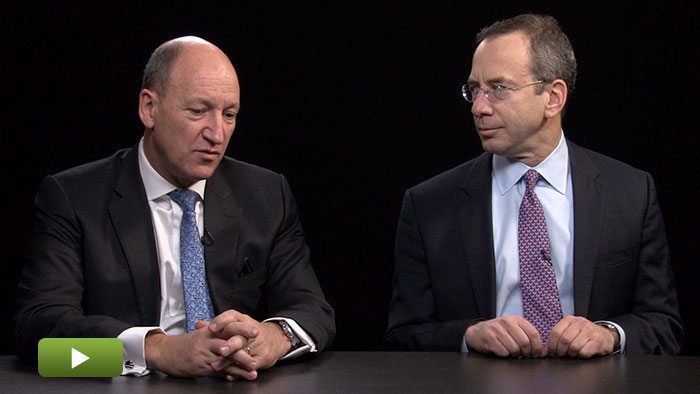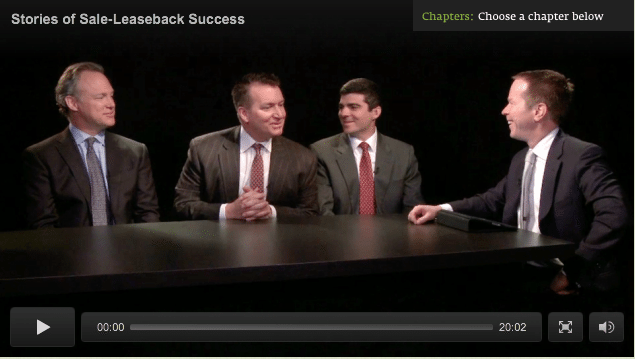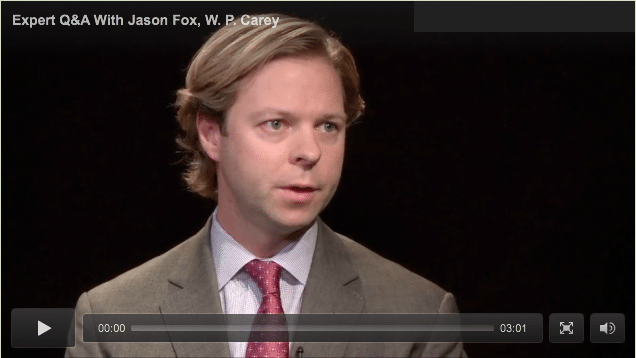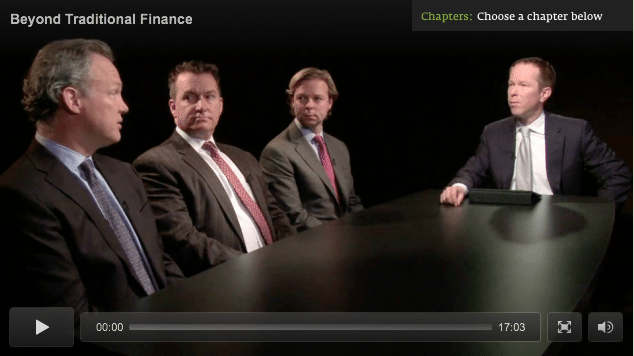Deal Structure Toolkit
When a private equity GP considers a potential acquisition, the first two questions should be: “How can I improve this business?” and “What is the right capital structure for the deal?”
The latter challenge is the focus of the second segment in a fascinating conversation between Christian Oberbeck, a Managing Partner with Saratoga Partners; Kenneth Clay, a Senior Managing Director at Corinthian Capital Group; and Gino Sabatini, a Managing Director with W. P. Carey.
Oberbeck sets forth the many forms of financing available to a resourceful business acquirer. The experts discuss how GPs assess and then execute important non-traditional forms of deal finance, such as sale-leaseback and seller financing. Other topics include unlocking the value of property to finance growth midway through the investment period, using non-real estate assets as the basis for a sale-leaseback, solving complex real estate ownership issues, defining the use of financing proceeds and risking being too creative in structuring a proposed deal.
Transcript Download Transcript
David Snow, Privcap: Today we are joined by Christian Oberbeck of Saratoga Partners, Kenneth Clay of Corinthian Capital Group, Gino Sabatini of W.P. Carey. Gentlemen, welcome to Privcap today. Thanks for being here.
Today we’re talking all about creative finance, or rather alternative forms of finance that can be included in a private equity investment, strategy whether it’s at the deal stage or whether it’s during the life of the ownership of the portfolio company. I’m interested in sort of really getting into details about how these options work and how you deploy them in your private equity strategies.
But maybe, starting with Chris, can you talk a bit about what are the biggest, most well-known tools in the toolkit as far as alternative finance that a private equity firm can deploy in its investment of a company.
Christian Oberbeck, Saratoga Partners: Well, maybe to start, we’ll just start with all the tools on the list. At the top of the structure, you’d have a typical revolving credit, asset-based facility, which would be based on inventory and receivables. Then you might have a senior loan, which could incorporate that, but would be first lien securities, secured by all the assets of the company on a first lien basis. Then you can have a second lien financing, which comes behind the banks, but ahead of everybody else.
Then you might have mezzanine financing, which would be generally unsecured and junior to the senior lenders. You might have sale-leaseback financing, which would be maybe not as usual, a little unusual. Sometimes you might have a unitranche financing, which would encompass mezzanine and first lien and asset-based financing all in one. And then generally you have your equity finance.
Also depending on the size of the company, you might have access to the high-yield bond market. Generally speaking you need about $150 million of value of a high-yield bond to be publicly tradable and to hit that market window. Then with all those elements, you have combinations of those elements and you can’t necessarily use all of them in a given transaction. So it depends on the business and what you’re trying to accomplish with the business and what you need.
Some people might do a revolving credit facility, and then a very large second lien financing, which might be all the financing they use up to the equity. That would be for a situation where you maybe had a lot of assets, but you wanted to get the lowest cost of financing, and you would secure all those assets.
But every deal is fact-specific, as Kenneth said. And for a sports analogy– you have all your players, but you’ve got to figure out how you configure those players compared to the specific game you’re playing and the specific deal.
Sometimes you have competition, too. You’ve got to figure out, how do I get the highest price to pay relative to my competition? In those instances, then you’ve got to get very creative to push all your financing alternatives to figure out how you can get the price to a level that’s going to clear the market for you.
Snow: Ken, as you’re investing and as you’re evaluating opportunities, how do you weigh the attractiveness of the various options that Chris has described. There’s price. There’s the sharing of risk between parties. How do you think about those as you’re trying to decide what’s the most appropriate or the most attractive structure for your investments?
Kenneth Clay, Corinthian Capital Group: Well, I think there are two or three major criteria by which you judge the financing. One is your weighted average cost of capital. So you want to be efficient in that regard. Then of course you’re also considering safety, and trying to protect against a downside scenario that could harm your equity investment.
So those are really kind of the two key measures that we look at. You will try to get as creative as you can within the range of possibilities available to you, in order to optimize both of those variables.
Snow: Gino, you and your firm specialize in sale leaseback finance. As you are working with a private equity sponsor on, potentially, a deal, how do you frame the attractiveness or the potential attractiveness of the kind of financing that your firm offers?
Gino Sabatini, W. P. Carey: Well, there are a lot of advantages to a sale-leaseback. Jason touched on many of those in the last session. The first thing we usually talk about when we begin a conversation with a private equity firm is the importance of the asset to the company going forward.
That impacts the decision on many fronts. It impacts the attractiveness of the deal to us. It impacts the decision of the private equity firm, as to whether or not they want to enter into a very long-term obligation. And often it will impact the saleability of the company down the road.
For example, if they did a sale leaseback on a nonessential manufacturing plant, and maybe the potential exit for the PE shop four to five years down the road is to a strategic, which may have its own manufacturing footprint, entering into a long-term lease might not be a good idea. So we really want this to be the right thing for the private equity shop. We don’t want to be stuck with an asset that, four years down the road, they’re looking to get out of.
So that’s always part of the first conversation. Is this important to you? And is this the right decision for a long period of time?
Snow: Well, now, there’s different stages in the life of a private equity investment at which some form of creative finance, such as sale leaseback, might make sense. It’s not just at the outset, right? There’s also an opportunity to use this form of finance to help the company grow or to make an add-on, right?
Sabatini: In terms of the sale-leaseback, absolutely. I would say 25% of our business is what we call build-to-suit financing, where a company has a need for a new facility, and they’ll come to us and they’ll say, listen, we really don’t want to come out of pocket for the entire cost of this facility. Could you build it for us and we’ll lease it from you. That’s a big piece of the business.
Add-ons to existing facilities is another, I guess, extension of the same idea. The private equity shop may own a company that has a plant. The plant does not have enough room. They need to expand. They’ll come to us and we’ll put the money in to do the expansion.
Snow: So Ken, when you think about using creative forms of finance, how do you think about it sort of midway through the portfolio company’s investment life with your firm? What are some options that you have, and how do you think about helping the company grow using non-traditional forms of finance?
Clay: Well, I think once you own the business, it kind of depends, again, on what’s happening with the business. is it performing very well? Is it underperforming? Are your current lenders happy with you? But sometimes you have a situation where the business is optimally financed, and you need some additional capital and the traditional sources aren’t available.
That’s were something like a sale leaseback can be very useful, particularly if it’s expansion-driven. Then you can do a build-to-suit or you can take an asset that was on the books, and do a sale leaseback and free up some additional capital, the use of proceeds sometimes being paying down existing indebtedness to allow you to run the revolver back up as a company grows and needs additional working capital. That kind of thing.
Snow: Chris, how often do you, midstream in an investment with one of your portfolio companies, pursue some form of creative finance to kind of get it to the next level?
Oberbeck: I don’t know if I’d say often, but certainly we do it. Sometimes when you’re in a business, you find assets that maybe you weren’t aware of that are financeable. We had one instance where we had some precious metals, largely platinum, that were involved in a glassmaking furnace for one of our facilities in Germany. And it turned out that we could do a sale leaseback of the platinum.
So we did that, and it was on a very favorable basis relative to financing it with our bank debt. So we did that, and that was something that took a while. I mean, it took us over a year to get it done, and we went to a lot of different institutions to get it done. But ultimately we were able to get very favorable treatment on an asset that was– it freed up significant capital that we could redeploy within the business.
Sabatini: You found a stash of unknown platinum?
Oberbeck: No, we knew we had it. It’s just it wasn’t financeable when we first started. And then the markets developed for it to be financeable. It also took a while to find the right entities to finance it. You have these assets, but they’re not always readily financeable. The market’s come and go for these things.
Something like platinum– it went up a lot. It went down a lot. That’s not everybody’s favorite sale-leaseback thing. But at a certain point in time, we were able to get that type of financing. We weren’t before that, and we weren’t after that. It comes and goes. So you have to be aware of what your assets are and then how the markets for financing them evolve.
In sale-leasebacks, for example, if you’re selling through to a REIT. We have a company that’s in the assisted living business. The history of that company has been a combination of building real estate, selling it in sale leasebacks, buying it back in sale leasebacks, depending on where the market is. Sometimes a mortgage market is more favorable than the leaseback market, and vice versa.
So all these things change and evolve, and you need to be very focused on that and to constantly optimize your overall capital structure.
Snow: Now in addition to optimizing the performance and the value of the companies in which private equity firms invest, sometimes solutions like sale-leasebacks can solve ownership issues, right? Like maybe there’s not an optimal way that the real estate assets are owned, and so the sale-leaseback actually kind of accomplishes that. Is that a scenario that you sometimes come across?
Sabatini: That happens quite often, especially in the lower- to middle-market sized deals, where the company founder may own the real estate, and he’s been leasing it to the company at a set rate. Oftentimes, the buyer of the company wants the founder out completely, for many reasons. They’ll look to us as a third-party non-biased real estate owner to take the shoes of the owner.
Oberbeck: Sometimes you’re in a transaction and some of the real estate is associated with the business, but not absolutely necessary. The owner would like to get out completely, and the buyer would like to get in at the best value the buyer can get in at. They don’t really necessarily want or need the excess real estate. So sometimes that excess real estate can be an element of the purchase price. They go, we’ll pay your price, but you throw in that real estate.
Sometimes that real estate can actually be of quite a bit of value. We had a company we acquired from a very large company in India, and there was some residential real estate that was away from the facility that we were acquiring, that housed a lot of the people that lived there. But it was sort of a relic of the past, but it was on a very interesting industrial development site.
We actually were able to get that real estate thrown into the deal as part of the overall purchase package. Then subsequent to that, we’ve been working to get that real estate developed. That’s going to result in a significant decrease in, effectively, what we paid for the operating business.
Snow: I’ve been hearing that another form of getting creative with deals in order to maximize the value of the deal is the seller note. Ken, can you talk a bit about how that works, and also, are there seller notes, seller financing, happening in today’s market?
Clay: I think there are. It basically is a form of financing that the seller would provide, usually on terms that are fairly attractive. Again, it varies, but it may be something that is priced a little bit above the senior financing, but probably below third-party traditional mezzanine financing. You see sellers willing to step in and bridge a financing gap that the market can’t or is not really very willing to on a commercial basis.
So during the credit crisis, you saw a lot of seller financing because there was just very little bank financing and virtually no cash flow financing. In a more robust market, you’ll probably see seller financing more where there is a valuation gap to be bridged, if there’s a business that’s in transition.
The seller is going to be unwilling to sell their company, in effect, on the cheap, if some good things happen. But they’re in process, and so that’s not something that some of the traditional lending markets will be willing to advance against. Again, if it’s a lower growth situation, or a situation where you just can’t over-equitize it, or don’t want to, then that allows a seller who has conviction around these events in question to kind of put their money where their mouth is.
Frankly, if the company delivers and hits those benchmarks and so on, then the business is worth more, but you can still get the returns because you have the leverage. And if not, then you haven’t overpaid and the seller is able to get a deal done.
Snow: Speaking of confidence and closing the transaction idea, Gino, how often is it the case that the price is not what the private equity firm had hoped for the real estate assets involved in the sale-leaseback? Or how often is it that the real estate is just so obscure or there’s just no demand for it, that it doesn’t make sense?
Sabatini: I would say it’s not the price, normally, that keeps a PE shop from doing it. It’s more the criticality. Sometimes it’s the timing and sometimes it’s the size of the deal relative to the rest of the capital structure. If there’s a billion-dollar buyout getting done, and there’s a $30 million building in the company, they may do that after the fact. But they’re not going to rely on that $30 million and spend time on that $30 million as part of the initial acquisition.
So the size of the sale-leaseback has to be significant enough that it makes sense to focus on it initially. All the other factors have to have to be lined up properly. It has to be important to the company, no environmental problems, and so on and so forth.
Oberbeck: Sometimes in those circumstances, while you might not have the time to do it on the front end where you’re locking up the deal, over time what you want to do is allow for that. So you might negotiate with your lender group and make sure and say, look, we would like to do a sale leaseback of this asset, and then make sure that you define the use of proceeds and all of that. Because you don’t want to necessarily do a sale-leaseback and just pay it off your senior, least expensive debt.
So there might be some sharing. Maybe some proportion goes to the senior lenders and some proportion goes to the company, or something like that. So you want to be thinking about all these things and planning for these things. But the exact sequencing of how you do that is really driven by what your deal dynamics are.
Snow: If traditional financing– let’s say senior debt plus equity– is the most straightforward way to do a deal, does pursuing some of these alternative forms of finance, whether it’s sale leaseback or seller finance or asset-based– does that tend to slow down the deal? Or is it the case that if all parties involved see these as being attractive options that it can reach closure in the same amount of time as any other deal? Do you ever come across people that just aren’t used to that kind of a transaction?
Sabatini: Sure. We have to talk them through it. Our timeline is about 30 days. So if they have 30 days, we can get it done. Any additional layer of financing you introduce is going to introduce potential delay. The easiest thing is all cash. But not many people buy companies that way. So as Chris said, it’s a balance of all the different factors and doing what’s optimal at that point in time.
Snow: Have either of you ever gotten too creative, and that’s impeded the progress of a deal that you really wanted to close?
Oberbeck: Well, usually it’s kind of like a feedback loop. In other words, you’re bidding for the company. You come up with the first, best package you have. Either you’re in competition, or they tell you you’re in competition, or the seller wants something else, and you’ve got these gaps. The question is, how do you bridge the gaps in the deal? Then you go back and kind of relook at everything.
Sometimes there are these unusual assets there. Then, if all the buyers are at X, and then you can find a way to get creative to get at X plus Y, that can be the difference between winning the deal or not winning the deal. But usually that sort of comes out of a process of back and forth, working around it.
Then you might say, OK, well, there’s a sale leaseback. That $30 million sale leaseback. Maybe that $30 million is the difference on a billion-dollar deal. And somebody says, I have confidence that I’m going to be able to get that done. So they’ll say, I’ll put, effectively, my equity in now, and I’ll take the risk that it gets done.
Sabatini: Yeah, and some of these unique assets are really hard for the seller to value sometimes. If they have an old manufacturing plant in the middle of nowhere, they may think it’s not worth a lot. But if it has heavy infrastructure that’s hard to duplicate, it may be worth more than they think. So as Chris said, these things turn up as you have conversations with the company, and the structure of the deal often changes.
Clay: You sometimes, though, can be too creative if you have a partnership deal, where you’ve got an owner/operator or a founder who is going to retain 30% or 40% of the business. Maybe they’re risk-averse or debt-averse, or they don’t feel comfortable with some of the more sophisticated financing techniques. Then you do get into that feedback loop or the dialogue that was mentioned a moment ago.
We sometimes forget that we’re in the financing business and in the leverage business, and this is all very familiar to us. So on the smaller deals in particular, where the owners continue to stay very involved, or the old owners I should say, then occasionally you get some pushback.
Expert Q&A With Jason Fox, Co-Head of Domestic Investments, Managing Director, W. P. Carey
From a private equity perspective, how does a sale-leaseback work?
Jason Fox: A sale-leaseback is a relatively straightforward transaction. A corporate owner-user who has a long-term need for the sale-leaseback but wants to unlock the value and the equity tied up into that real estate will choose to sell their real estate to an investor like us, W.P. Carey. In turn, they’ll get 100% of the market value of the real estate. We, in turn, will execute a lease with that company and get a long-term income stream that our investors are looking for.
Are sale-leasebacks only executed at the outset of a private equity deal?
Jason Fox: These sale-leasebacks can happen at any point in time with a company. When we work with private equity firms, there’s really a number of reasons why they would do these. First and foremost, it is an illiquid asset. For them, they’re able to unlock equity by doing a sale-leaseback at this point in time, whether it’s initial financing of the transaction when they buy a company. They can capitalize their investment with your typical sources of equity and debt, but also some alternative financing such as a sale-leaseback. It adds leverage to the equity. It also decreases the cost of capital.
What is ‘cap-rate arbitrage’?
Jason Fox: When a private equity firm does a sale-leaseback, there is this cap-rate or multiple arbitrage that occurs, especially when they’re buying industrial companies that tend to trade at lower multiples. For instance, an industrial company that they may be buying for six times cash flow that owns its manufacturing plants, its corporate headquarters, maybe some distribution plants. We can do a sale-leaseback on that and current pricing in the sale-leaseback market, based on cap-rates or capitalization rates, are typically in the 7% to 10% range, which is effectively equal to a 10 to 14 times multiple for those cash flows. So the simple math is, if they’re buying companies for six time cash flows and selling a portion of those cash flows in the term of rent to us at 10 to 14 times, it’s immediately accretive to their equity.
Where in the world does W. P. Carey operate?
Jason Fox: Well, W.P. Carey’s truly a global firm. We currently own assets in 18 different countries. We can do cross-border transactions. We’ve done a number of deals in which, certainly in North America, are more common. We have a company that has distribution facilities across Canada, the United States, and Mexico where we’ll do those seamlessly.
In fact, a big part of our business is doing follow-on investments with private equity firms. We tend to follow our tenants, our partners in the private equity firms, to other countries. As they buy new portfolio companies, whether it’s in emerging markets such as Brazil or in established markets in Europe, we’re able to do sale-leasebacks with them. After you do your first transaction, each follow-on tends to be even more seamless.



